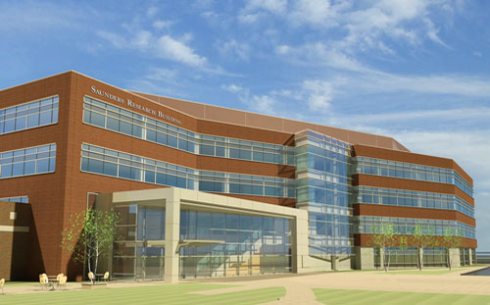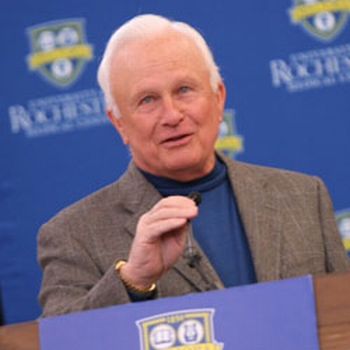URMC Medical Center Opens New Building Dedicated to Advancing Care
URMC Medical Center Opens New Building Dedicated to Advancing

- Architect rendering of the new Saunders Research Building
University of Rochester officials were joined today by Lt. Governor Robert Duffy and New York State Assembly Speaker Sheldon Silver to officially open the doors on a new research building at the Medical Center dedicated to cutting the time it takes to turn new ideas into better care for patients.
“While our understanding of disease and the role of behavior and the environment on health has exploded over the last several decades, the reality is that the application of this new knowledge does not happen as regularly or easily as we would like,” said Bradford C. Berk, M.D., Ph.D., CEO of University of Rochester Medical Center. “This facility was created with the understanding that the future of medicine will be driven by institutions that assemble the teams and create the environment necessary to follow through on discoveries and make them relevant in terms of improving health.”
“This building positions the University of Rochester Medical Center at the forefront of a national movement to break down the barriers between the lab and the lives of people,” said Joel Seligman, president of the University of Rochester. “We are deeply grateful for the investment made by New York State – under the leadership of the governor’s office, Speaker Silver, and Assemblymen Morelle and Gantt – in the construction of this facility. This support was essential and the work that will go on inside this building will help propel local economic growth, foster academic and private partnerships, and improve health.”
The concept of creating a physical home for clinical research at URMC gained momentum in October 2006 when the Medical Center was one of the first institutions in the nation to receive a Clinical and Translational Science Award from the National Institutes of Health (NIH). This $40 million award – the largest in URMC history – allowed the Medical Center to build programs designed to accelerate the application of medical research. Soon after, the Medical Center committed to create a facility in which these activities – and many of the research programs they support – could reside. In 2008, then-Governors Elliot Spitzer and David Paterson and the New York State Assembly proposed and ultimately approved $50 million in capital support for the project.
Building to be Named in Honor of E. Philip Saunders
It was also announced today that the facility will be named the Saunders Research Building in honor of local businessman E. Philip Saunders for his decades of support for research at URMC. Earlier this week, the Medical Center announced a $10 million gift from Saunders to support research programs in muscular dystrophy, cancer, and translational medicine. In agreeing to lend his name to this building, Saunders has requested that it honor those who have served in the country’s armed forces. Within the Saunders Research Building, a display will be created to serve as a lasting reminder of his gratitude for their sacrifice. Read more about E. Philip Saunders.

- E. Philip Saunders
“We are deeply grateful to Phil for his decades of support – much of it done anonymously – for muscular dystrophy research,” said Berk. “I can think of no more appropriate way to recognize their long dedication to advancing promising research than naming a building that embodies that goal in their honor.”
The Saunders Research Building will serve as the hub of clinical and translational medicine for both the Medical Center and a network of researchers across the state. It will be home to the Clinical and Translational Science Institute (CTSI) which was created in 2007 to provide researchers with the comprehensive set of services, expertise, and resources necessary to carry out all phases of translational research from the point where a new idea is first tested in humans all the way to evaluating the cost and effectiveness of new therapies on a community-wide scale. The CTSI also funds pilot research, oversees new graduate programs in translational medicine, and serves as the nucleus for a network of 16 biomedical research centers in upstate New York.
The building will also house independent URMC research programs in cardiovascular disease, neurological disorders, cancer, pediatrics, and emergency medicine, the Departments of Community & Preventive Medicine and Biostatistics & Computational Biology, and the Office for Human Subject Protection. Read more about the building’s occupants »
URMC has been a pioneer in the field of translational medicine, including work which was instrumental in the development of pediatric, influenza & cancer vaccines, vision correcting surgery, implantable cardiac defibrillators, drug safety initiatives, medical imaging technologies, and new treatments for numerous neurological disorders. The building’s emphasis on translational medicine will also serve to complement the Medical Center’s core strength in basic biomedical research which focuses on understanding the mechanisms of disease. The goal of translational medicine is to take scientific breakthroughs in the form of experimental drugs, medical devices, and behavioral studies and more rapidly and methodically apply them to real world health problems.
“For scientists who have spent most of their career at the lab bench the process of translating their work into new therapies can be daunting,” said Mark Taubman, M.D., dean of the School of Medicine and Dentistry. “This building was constructed with the recognition that translational medicine is a completely different discipline and requires people with the knowledge and experience necessary to take new ideas, move them through the many stages of testing and evaluation, and bring them to the point where they will ultimately improve the lives of patients.”
The Saunders Research Building was designed with the goal of creating a facility that will be a model for sustainability and scientific collaboration. The facility is eligible for Leadership in Energy and Environmental Design certification and state credits for energy conservation. The building’s open configuration and shared common areas are intended to foster interaction between its occupants and provide a gathering space for the community. Read more about the building’s innovative design »
“Meaningful advances in health require teamwork,” said Thomas Pearson, M.D., Ph.D., M.P.H., director of the Clinical and Translational Science Institute. “This facility will bring the spirit of collegiality and collaboration that has long been the hallmark of the University of Rochester to the field of translational medicine and – in doing so – will help remove the bottleneck that has long kept promising science from moving forward.”
While the central objective of clinical and translational medicine is to improve health, a 2007 report by the Center for Governmental Research notes that the NIH grant, the building, and related research will also provide a significant boost to the region’s economy. The report estimates that this activity will create 600 permanent jobs at both the Medical Center and in the community and have a total annual economic impact of $30 million per year. It will also serve to strengthen academic and industry partnerships by helping advance new medical technologies to the point where they can be more readily transferred to the private sector.
* The above story is reprinted from materials provided by University of Rochester Medical Center




















